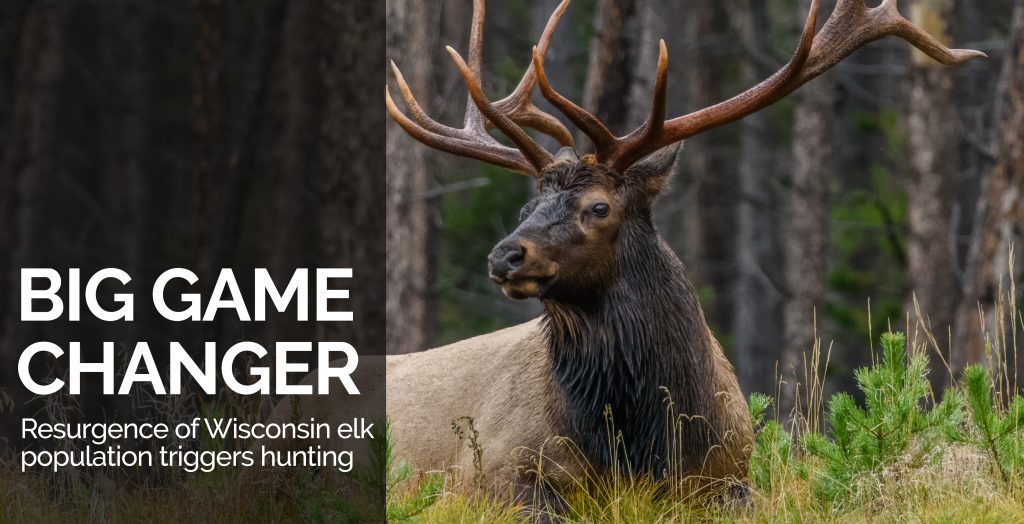
— all images courtesy of the Wisconsin Department of Natural Resources
A lone, muscular bull elk trods across the matted grass of the Northern Wisconsin landscape. He pauses and examines a grassy opening surrounded by forest as he hears a bugle sound in the distance. Marked with a red collar, this bull is one of more than 200 elk in the Clam Lake area of the state.
While seemingly comfortable in its lush green setting, this elk’s survival along with the rest of its herd has not always been secure. But this time, they may be here to stay.
A rise in human settlement in the 1800s, and the overhunting and habitat loss that came with it, wiped out elk in Wisconsin. An attempt was made at reintroducing them in the 1930s but was unsuccessful due to poaching, and elk here died off by 1948. After elk disappeared from Wisconsin twice, the state’s Department of Natural Resources arranged for the transportation of 25 elk to the Clam Lake area in 1995. They were at the genesis of a journey, trying to rebuild a species once native to the state. It has now been 23 years, and the elk population has grown slowly but steadily, reaching stability and allowing for the state’s first-ever regulated elk hunt in 2018. To prevent these native creatures from disappearing again, the DNR and the Rocky Mountain Elk Foundation have made significant habitat restoration efforts over the years and placed strict guidelines on the hunt. However, the DNR is still far from reaching its population goal of 1,400 elk, and it’s still not clear the herd will thrive in Wisconsin.
The first year of the reintroduction in 1995 was met with immediate setbacks, paving the way for a slow population growth. Four of the 25 original elk brought from Michigan died, causing the first of multiple population declines. According to Laine Stowell of the DNR, a standard and healthy starting point for a population is from 50 to 100 animals — and the more the better. Essentially, starting with only 21 elk raised concern of the genetic success for the population.
“You’re not going to get great reproduction the first couple of years,” says Kevin Wallenfang, a DNR big game ecologist. “So every animal you lose doesn’t necessarily get replaced right away, like it would when that population is at a more stable level.”
The population began to grow steadily at a rate of 20 percent, but then eventually tapered off. Questions still remained as to whether the population could continue to grow to become reproductively stable. As the population evolved, so did the DNR.
A turning point came in 2012, when the DNR developed an amendment to its elk-management plan, which included an increase of 75 elk in the Clam Lake herd in 2017. In 2015 and 2016, the DNR also introduced a new herd from Kentucky to the Black River area in Jackson County in western Wisconsin. The Black River herd currently numbers 65 elk, and the Clam Lake herd has reached more than 200.
“We’re right at the verge of exponential growth with our elk herd,” Stowell says. “We’re on the fast track to complete and fulfill that goal of 1,400 elk. It’s going to take probably a half a dozen or more years. But we’re right at the beginning of vast population growth.”
In 2018, the Wisconsin hunting season expanded to elk for a select few hunters. While deer hunting is familiar to many Wisconsinites, hunting elk is unique and a once-in-a-lifetime experience. Only four hunters in a lottery of more than 38,000 Wisconsin residents were selected by the DNR. One hunting license went to the winner of a raffle from the Rocky Mountain Elk Foundation, which works with the DNR to help manage the populations. An additional five tags were given to Native American nations.
Because the Clam Lake herd population is currently stable and thriving, Tim Van Deelen, professor of forest and wildlife ecology at UW–Madison, whose lab focuses on large mammals in Wisconsin, does not see the hunt having a negative impact. He suggests that humans, when regulated, are no more threatening than any natural predators, such as wolves.
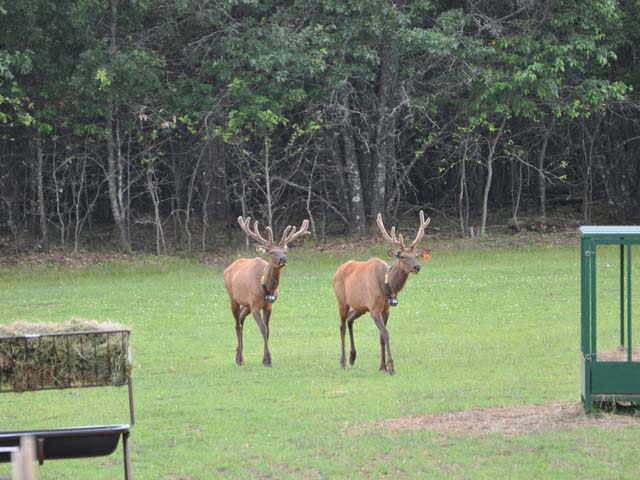
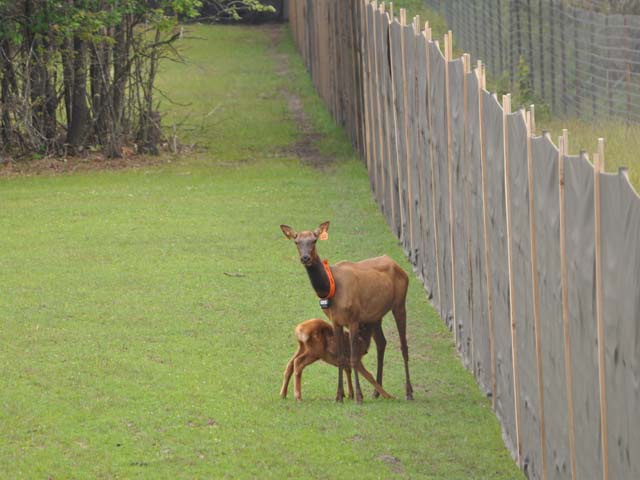
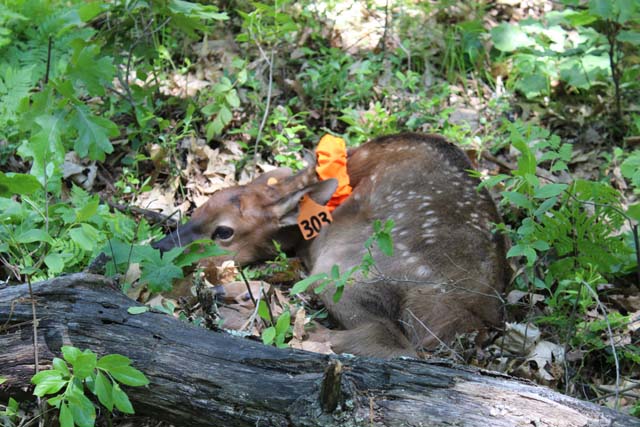
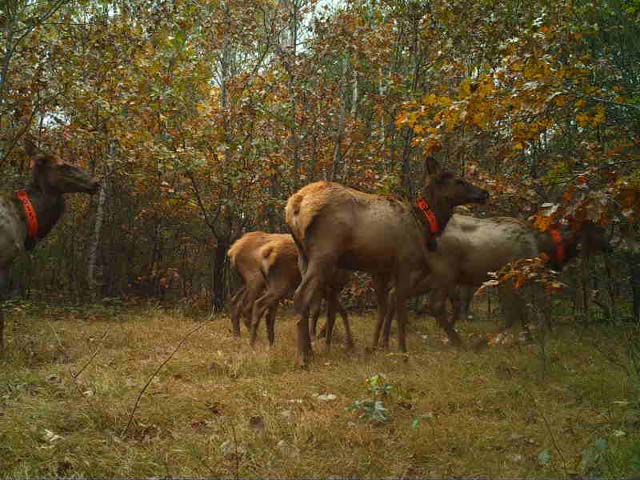

“The most simplistic sense is that human predation in the form of hunting can replace some of the natural predation that might happen, and then the other mortalities tend to adjust to accommodate,” Van Deelen says. “I expect that we’ll learn a little bit about how the population responds to hunting, and then the managers can tailor that for the next season, and eventually even that will stabilize.”
Despite having many strict regulations and guidelines, the DNR cannot completely control the actions and intentions of individual hunters. In October 2018, the Rocky Mountain Elk Foundation raffle winner was charged with illegally shooting a bull elk across a roadway. The elk population originally disappeared due to unregulated hunting, and the state’s institutions have worked hard to protect the elk. While this is a singular event, it taints the inaugural hunt.
Another factor in the loss of elk was a sudden change in the Wisconsin landscape; everything in the southern two-thirds of the state became farmland. Restoring a species that used to be here, Van Deelen says, only makes sense if the things that caused the disappearance in the first place are either gone or could be mitigated.
According to Van Deelen, elk tend to like open areas such as savannas and prairies more than deer do. Restoring some of the oak savannas of central Wisconsin would help expand the habitat for the elk, allowing them to eventually roam in more southern parts of Wisconsin and expand their presence statewide.
“Our prairie is, for the most part, gone because it got plowed under,” Wallenfang says. “Wisconsin is no different from a lot of states like Iowa and Minnesota, where elk were in abundance at one time, and human encroachment changed that.”
As for the Clam Lake herd, Wallenfang attributes the decline in population growth a decade ago partly to overgrowth of forests. As a forest ages, it offers elk less in terms of its food abundance and ability to escape predators.
“As that habitat matured, population growth slowed down,” Wallenfang says. “Now some of that is starting to turn around. There’s more habitat work; there’s more logging occurring in the primary area of where those elk live.”
With more logging happening now than 10 years ago, forest services and private landowners are able to positively affect the elk’s environment. Radio collars are also used to keep track of elk and assess birth and mortality rates.
Despite the extensive efforts of the DNR and Rocky Mountain Elk Foundation to protect the elk, there are some things that they cannot manage.
The severe winter of 2013-2014 caused setbacks to the Clam Lake herd through both temperatures and predation. With the temperatures being so low and an increase in predation due to lack of deer, the herd lost 22 percent of its cows, 20 percent of its bulls and 85 percent of its calves.
“Mother Nature, being outside of our control, is hard when you’re dealing with such a low volume of animals, and once you get to a point where they can grow at an exponential level, then that uncontrolled situation becomes less of a factor,” says Nicole Schaefer, a volunteer for the Rocky Mountain Elk Foundation.
While elk in Wisconsin will never be as common as deer, their populations are on the rise. A final release of additional elk in Clam Lake is planned for 2019. With that, experts believe the many years of population uncertainty are in the past, and elk are here to stay.
“Being able to see those animals in our state — who are a native species to [Wisconsin] — is important,” Schaefer says. “The conservation of land that goes along with that just ensures that my children and my grandchildren will be able to have places that they can go that are public access, free of charge, and be able to enjoy the four seasons of Wisconsin and all of the natural beauty that we have here.”

Andrew is an online associate and a senior majoring in journalism with a focus in reporting; he is also earning a digital studies certificate. When he's not at his computer, you can find Andrew in the pool as a member of UW-Madison's diving team.